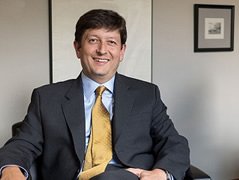The Arts and Sciences of Leadership
Former Syracuse physicist Sacha Kopp is Stony Brook's new liberal arts dean

Sacha Kopp believes in hands-on education. Literally.
When he was a physicist in Syracuse University’s College of Arts and Sciences, he helped build an instrument for a particle accelerator at Cornell University that was used by more than 400 scientists at 20 universities around the world. A few years later, at The University of Texas at Austin, Kopp was involved with constructing a particle beam facility.
Both endeavors have endeared him to the international physics community, while proving that good research often requires a little elbow grease.
“Sometimes, a research project has no infrastructure, so you have to roll up your sleeves and do what needs to be done,” says Kopp, speaking by phone from his office at Stony Brook University in New York, where he is the new dean of the College of Arts and Sciences. “Much of my career has been spent building laboratories to do work that hasn’t existed before.”
Kopp traces his work ethic to Syracuse, where, in the mid-Nineties, he served as a postdoctoral fellow and then a visiting assistant professor in the Department of Physics. There, he was mentored by professors Marina Artuso, Tomasz Skwarnicki, and Sheldon Stone, all of whom still serve on the faculty.
“Many young postdocs avoid responsibility, preferring to be closely guided by their faculty members. Not Sacha; he was different,” says Skwarnicki, citing Kopp’s “initiative and strong self-motivation.” “Even though he had limited experience in building detectors, he wanted as much responsibility as we’d give him—and more.”
With back-to-back degrees from The University of Chicago, Kopp was a mild-mannered Midwesterner at heart. But the chance to come east to Syracuse to collaborate with some of the biggest names in particle physics was too good to resist.
Kopp was particularly impressed by Stone's entrepreneurial swagger.
“Sheldon had the ebullience and confidence of an experimental scientists who would look at something and say, ‘Yup. We should try it,’” recalls Kopp, who is equal parts scientist, educator, and administrator. “I wouldn’t be where I am today without his mentorship.”
Stone returns the compliment, calling Kopp a “smart, hard-working scientist who’s willing to learn from his mistakes.” He still marvels at how Kopp, despite a myriad of setbacks, persisted in accomplishing his part of the Cornell project—an experience that set the stage for practically the rest of his career.
“Sacha grew tremendously in hardware talent,” Stone says. “At the time, I don’t think we saw ‘dean’ in his future, but, even then, we knew he had keen scientific insights and would be successful in whatever he attempted.”
Artuso agrees: “It was a pleasure seeing Sacha evolve from a young scientist, having just finished his dissertation, into a key member of the construction team of a very unique and complex particular detector. Since then, he’s expanded his horizon to include interesting physics analyses and has built a proven track record in teaching and administration.”
Kopp has come a long way from his halcyon days at Syracuse, where he taught courses and worked on the CLEO Collaboration at Cornell. (From 1979 to 2008, the collaboration used a high-energy physics detector at Cornell to detect new phenomena beyond the Standard Model of particle physics.) Kopp also served as Syracuse's liaison to the now-defunct Optovac, a leading maker of crystal optics in Central Massachusetts.
Building up Syracuse's research facilities also proved to be educational. “I remember acquiring this huge room, which, at one point, must have been somebody’s dumping space,” Kopp says. “We spent a good six months to a year turning it into a scientific cleanroom. The humidity was, like, five percent because the optics we worked on were sensitive to moisture. It was a crash-course in developing safe practices and procedures for research.”
Kopp says these kinds of experiences—first at Syracuse and then at UT, where he spent more than 15 years as physics professor and then an associate dean—helped him make the transition into administration.
They also taught him the value of teamwork.
“For me, scientific collaborations are not just about doing something technical, such as designing an apparatus or conducting an investigation; they’re about organizational management,” says Kopp, who also has worked on multiple experiments at Fermilab, a national physics laboratory outside of Chicago. “A scientific collaboration is a lot like a university, in that you often have hundreds of co-workers who speak different languages and come from different backgrounds. My job, as an administrator, is to get everyone on the same page, working together.”
Kopp, who recently relocated to Long Island with his wife, Gretchen G’98, and their two children, is excited about the new chapter in his career. A major research institution with a liberal arts edge, Stony Brook begs comparison to Syracuse.
“Liberally educated means being proficient in not only the sciences and humanities, but also public discourse and civic engagement,” adds Kopp, the author of more than 200 scholarly articles. “I've learned early on, as a student at Chicago and then as a teacher at Syracuse, that a liberal arts education is nonlinear. It can prepare you for almost anything in life."
Media Contact
Rob Enslin
